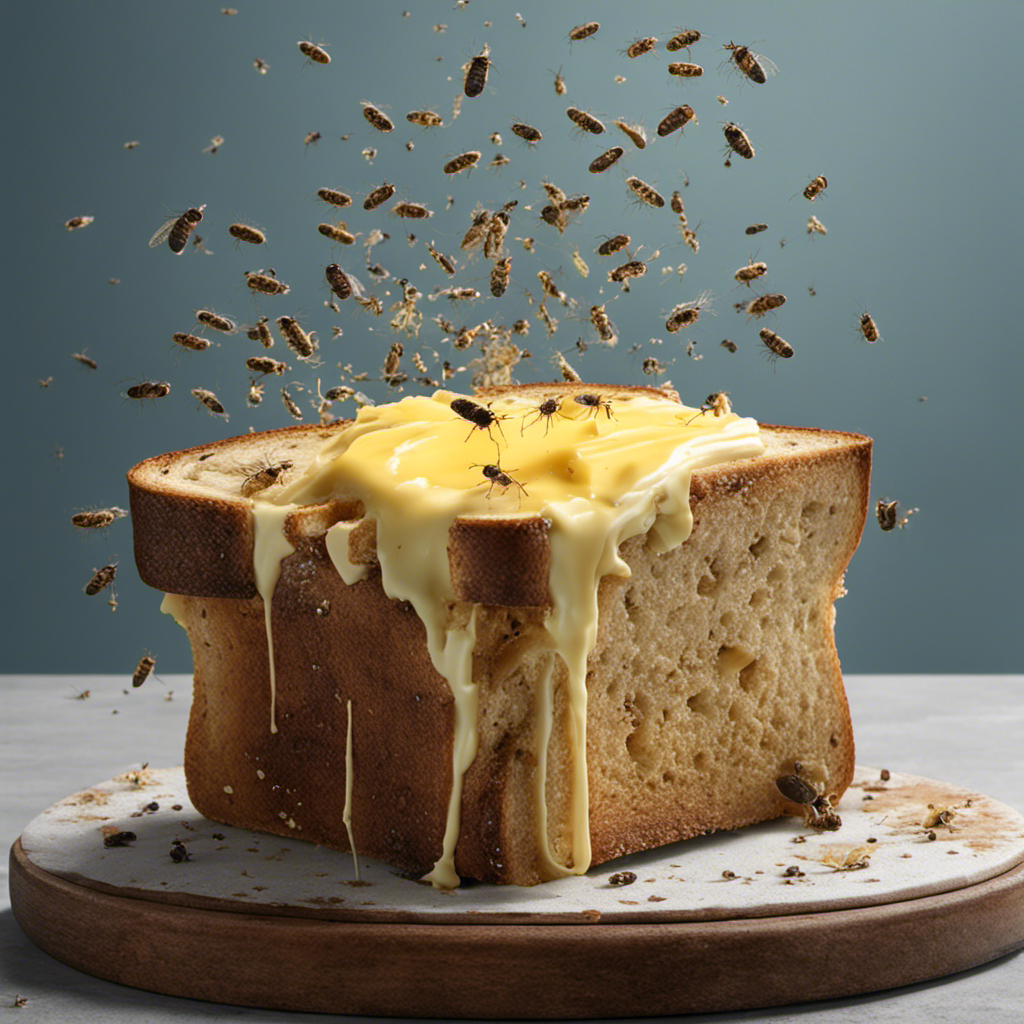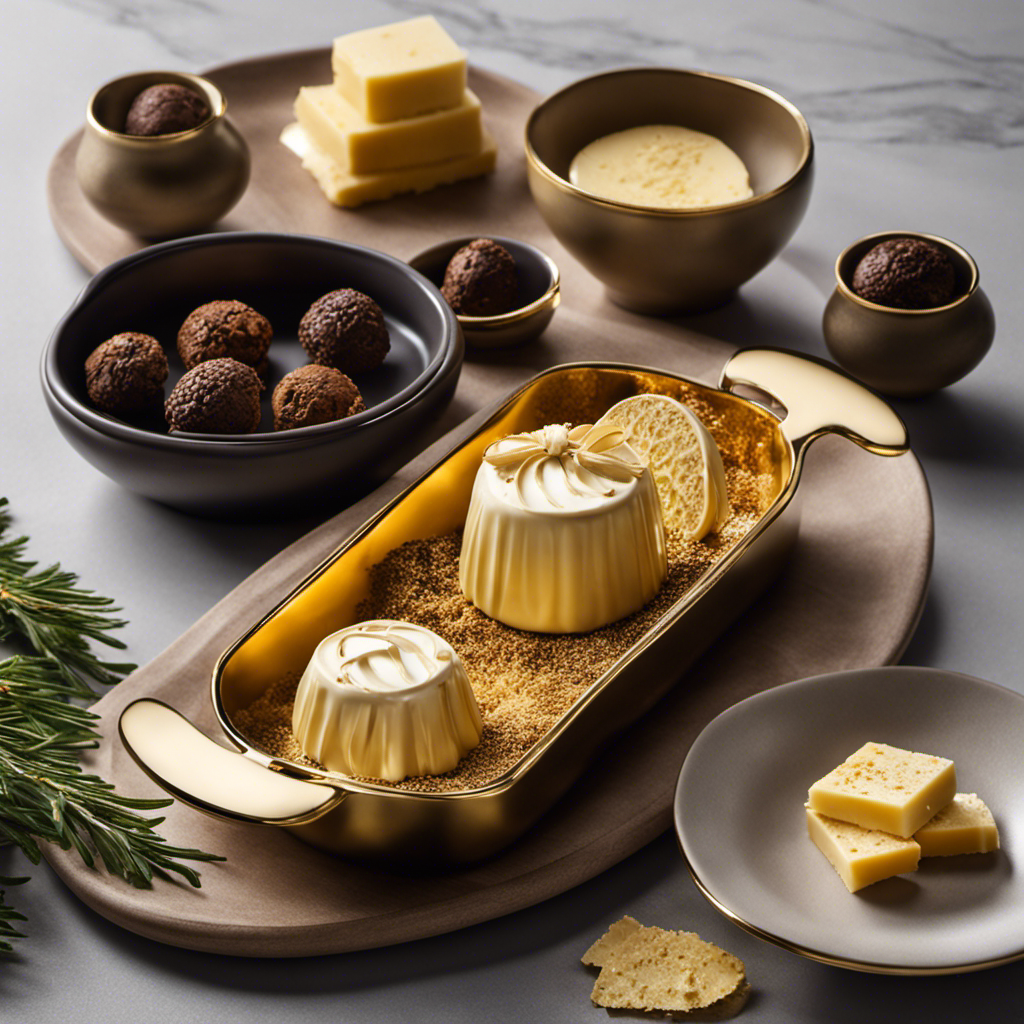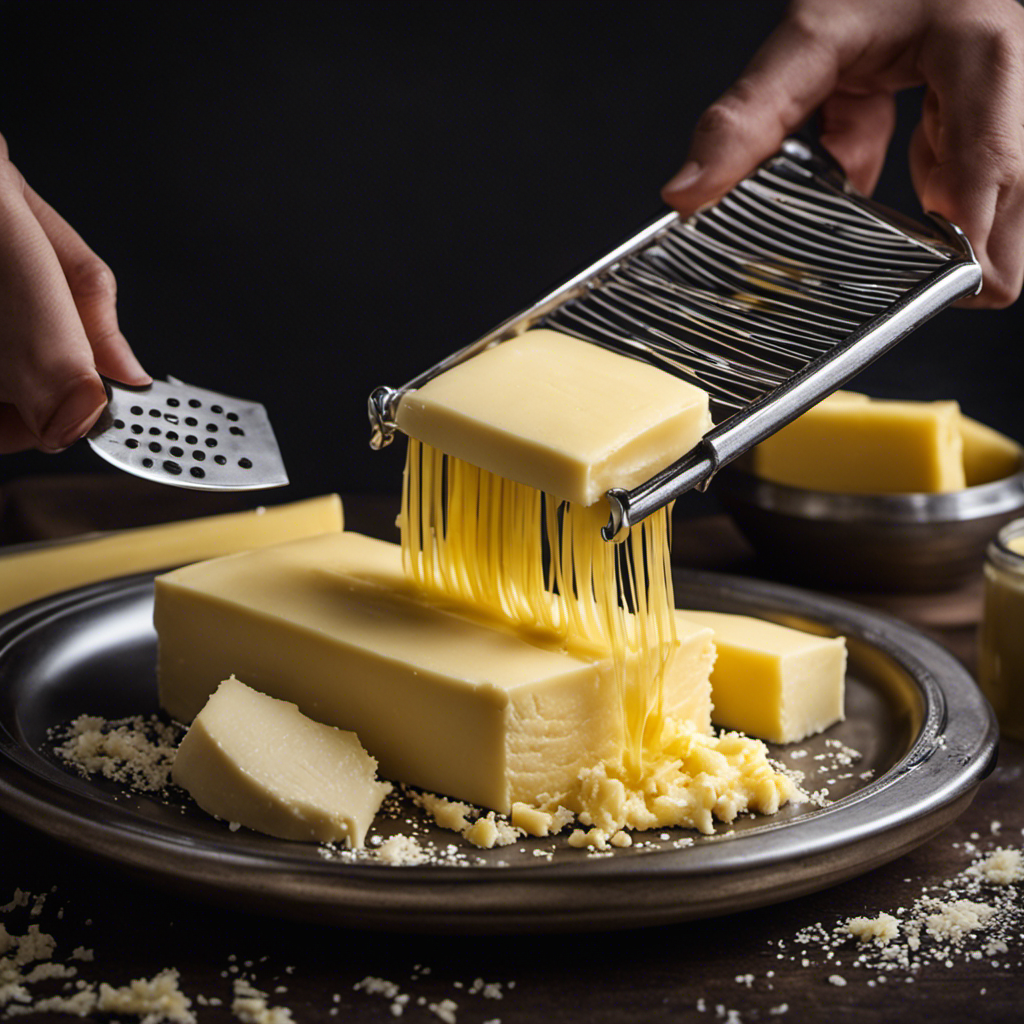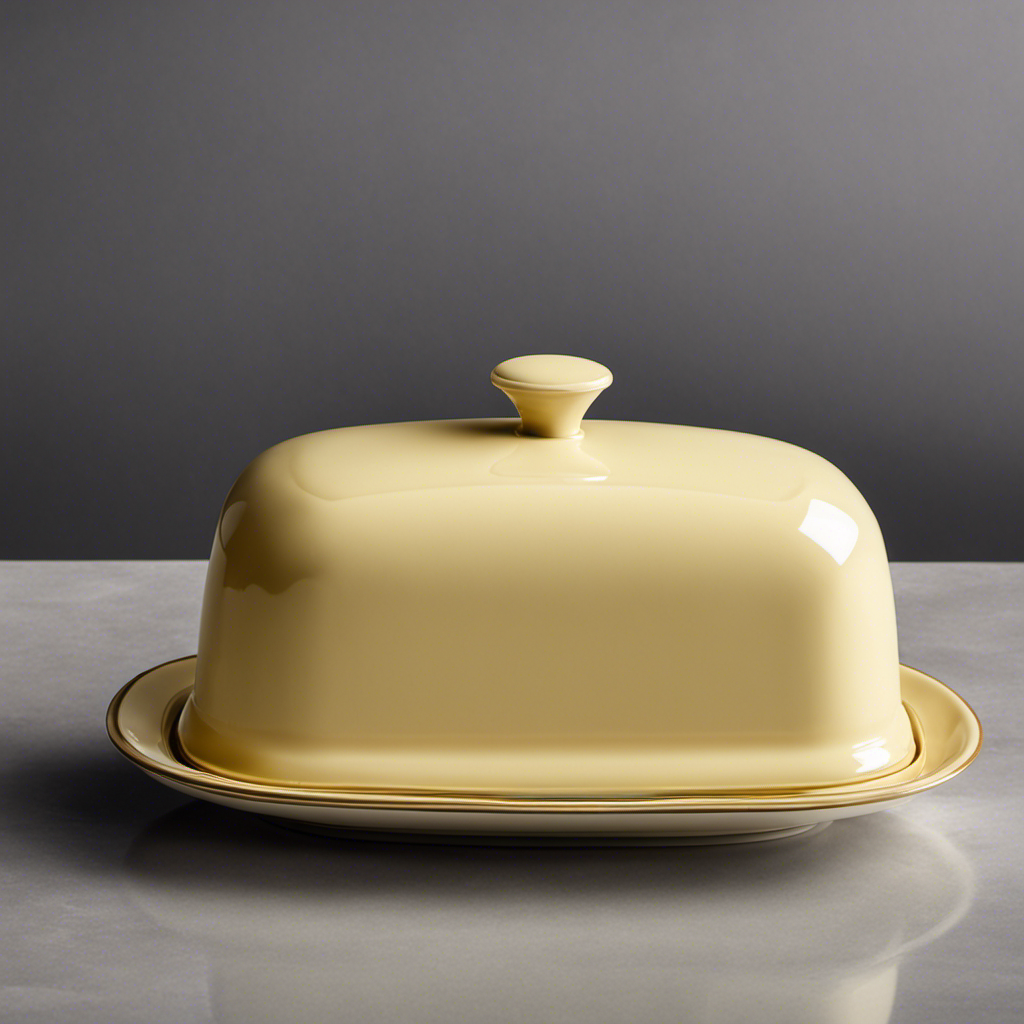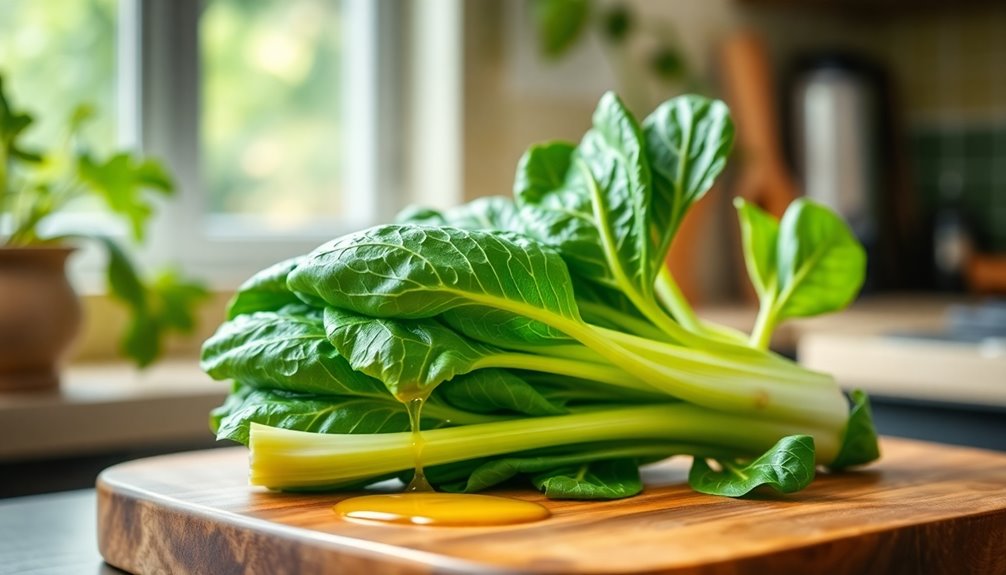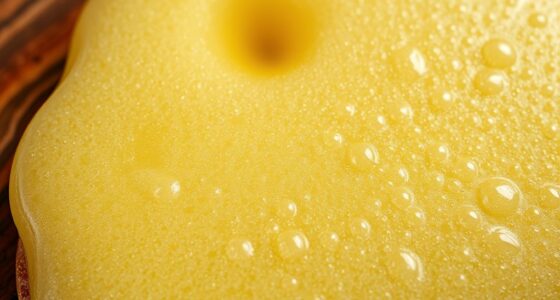As someone who loves the rich indulgence of butter, I have always wondered about the effects of eating butter that has expired.
Well, today, we’re diving deep into the world of expired butter and the potential consequences it may have on our health, taste buds, and even our cooking endeavors.
Join me as we explore the shelf life of butter, identify signs of spoilage, discuss any health risks involved, and discover safe alternatives for our favorite recipes.
Get ready to uncover the truth about eating expired butter!
Key Takeaways
- Consuming expired butter can lead to potential health risks such as allergic reactions, digestive problems, and food poisoning.
- Expired butter may have decreased nutritional value and can potentially cause nutrient deficiencies.
- Eating expired butter can result in an unpleasant taste and texture due to rancidity and changes in fat separation and moisture loss.
- Proper storage, checking expiration dates, and disposing of expired butter correctly are important to prevent spoilage and maintain a healthy diet.
The Shelf Life of Butter: Understanding Expiration Dates
The shelf life of butter varies depending on the brand and storage conditions. It is important to understand the expiration dates on butter to ensure its freshness and quality.
Butter is a dairy product that contains essential nutrients and fats. It is a good source of vitamins A, E, and K, as well as omega-3 and omega-6 fatty acids. However, as butter ages, its nutritional value may decrease.
Expired butter may also have a negative impact on recipes. It can affect the taste, texture, and overall quality of baked goods and dishes. Using expired butter in recipes can lead to unpleasant flavors and a compromised end result.
Therefore, it is crucial to check the expiration dates and properly store butter to maintain its nutritional value and avoid any negative effects on recipes.
Signs of Spoiled Butter: How to Spot the Difference
One way to spot spoiled butter is by checking for a rancid smell. If the butter has an unpleasant odor, it is likely spoiled and should not be consumed.
To prevent butter spoilage, there are a few things you can do:
-
Store butter properly: Keep butter in the refrigerator at a consistent temperature below 40°F (4°C). This will help slow down the growth of bacteria and prevent spoilage.
-
Use butter before the expiration date: Butter usually has a shelf life of a few weeks to a few months. Be sure to check the expiration date and use the butter before it goes bad.
-
Keep butter away from strong odors: Butter can easily absorb odors from other foods in the refrigerator, so it’s important to store it in an airtight container or in its original packaging.
If you discover that your butter has expired and is no longer safe to eat, it’s important to dispose of it properly. Here’s what you can do:
-
Check local regulations: Some areas may have specific guidelines for disposing of expired food. Check with your local waste management authority to see if there are any specific instructions you need to follow.
-
Wrap the butter: If there are no specific instructions, wrap the expired butter in a plastic bag or wrap it tightly in foil to prevent any leakage or odors.
-
Dispose of it in the trash: Place the wrapped butter in a sealed bag and dispose of it in your regular trash. Be sure to tie the bag securely to prevent any leakage or odors.
Potential Health Risks: Is Expired Butter Safe to Consume
To determine if expired butter is safe to consume, you should check for any visible signs of mold or discoloration. Consuming expired butter can pose certain risks and have health implications. Here is a table that outlines the potential health risks associated with eating expired butter:
| Risk | Health Implications |
|---|---|
| Presence of mold | May cause allergic reactions or respiratory issues |
| Rancidity | Can lead to digestive problems and discomfort |
| Bacterial growth | May result in food poisoning or gastrointestinal issues |
| Nutrient degradation | Decreases the nutritional value of the butter |
As you can see, consuming expired butter can have negative consequences for your health. It is important to be cautious and avoid eating butter that is past its expiration date. In the next section, we will explore the nutritional changes and how expired butter can affect your diet.
Nutritional Changes: How Expired Butter Affects Your Diet
As someone who’s concerned about maintaining a healthy diet, it’s important to understand the impact of consuming expired butter.
One key aspect to consider is the degradation of nutrients in expired butter. This can have a significant effect on your overall nutrition.
Additionally, there are potential health risks associated with consuming expired butter. These may include gastrointestinal issues and foodborne illnesses.
Therefore, it’s crucial to be aware of these factors and make informed decisions when it comes to using expired butter in your cooking and baking.
Nutrient Degradation in Expired Butter
Eating expired butter can lead to a decrease in the nutrients it contains. When butter reaches its expiration date, the quality and composition of its nutrients start to degrade. Here are some important points to consider regarding nutrient degradation in expired butter:
-
Nutrient Absorption: Expired butter may have a lower concentration of essential vitamins and minerals, which can affect nutrient absorption in the body. This can lead to potential deficiencies, especially if expired butter is consumed regularly.
-
Expiration Date Accuracy: It’s important to note that expiration dates on butter packages are a guideline for optimal quality rather than a strict safety measure. However, consuming butter past its expiration date increases the risk of consuming degraded nutrients.
-
Storage Conditions: Proper storage of butter can help slow down nutrient degradation. Exposure to heat, light, and air can accelerate nutrient breakdown, so it’s crucial to store butter in a cool, dark place to maintain its nutritional value.
Health Risks of Expired Butter
When butter expires, you should be aware of the potential health risks associated with consuming it. Expired butter may have reduced nutritional value and can pose a risk of food poisoning.
As butter ages, its nutritional content can degrade, resulting in a decrease in vitamins and antioxidants. This can be concerning for individuals who rely on butter as a source of certain nutrients.
Additionally, expired butter may harbor harmful bacteria such as Salmonella or E. coli, which can cause food poisoning. Consuming expired butter increases the likelihood of ingesting these harmful pathogens, leading to symptoms like nausea, vomiting, diarrhea, and abdominal pain.
To avoid these health risks, it is important to check the expiration date on butter and discard it if it has expired.
Taste and Texture: What Happens to Expired Butter
The expired butter’s taste and texture may change, making it unpleasant to consume. When butter reaches its expiration date, the quality starts to deteriorate. Here are some effects of oxidation on expired butter:
-
Rancidity: Oxidation causes the fat molecules in butter to break down, resulting in a rancid smell and taste. It becomes sour and develops a strong, unpleasant flavor.
-
Texture changes: The texture of expired butter can become grainy or greasy as the fat molecules separate and moisture evaporates. It loses its smooth and creamy consistency.
-
Color alteration: Over time, the color of butter may darken or become yellowish. This is a result of oxidation and the breakdown of the natural pigments in the butter.
Consuming expired butter can lead to an unpleasant dining experience and potentially upset stomach. It is best to check the expiration date and discard any butter that has passed its prime.
Bacterial Growth: The Dangers of Consuming Rancid Butter
Consuming rancid butter can potentially lead to food poisoning and should be avoided. When butter becomes rancid, it means that the fats in the butter have oxidized, causing an unpleasant smell and taste.
However, the dangers of consuming rancid butter go beyond just its foul taste. Rancid butter can also be a breeding ground for bacterial contamination, which can lead to food poisoning. Bacteria such as Salmonella and Listeria monocytogenes can thrive in rancid butter and cause serious illnesses if ingested.
Symptoms of food poisoning can range from mild stomach discomfort to severe vomiting and diarrhea. To prevent bacterial contamination and food poisoning, it is crucial to check the expiration date of butter and discard any rancid butter immediately.
Digestive Issues: Possible Effects on Your Stomach
Avoiding rancid butter is important because it can lead to digestive issues such as stomach discomfort and diarrhea. When expired butter is consumed, it can cause various digestive disturbances that can seriously impact our well-being. Here are some possible effects on your stomach:
- Upset stomach: Consuming rancid butter can irritate the lining of the stomach, leading to stomach discomfort and nausea.
- Diarrhea: The presence of harmful bacteria in expired butter can trigger an increase in bowel movements, resulting in loose stools and frequent trips to the bathroom.
- Bloating: Rancid butter contains toxins that can cause gas and bloating, making you feel uncomfortable and distended.
It is essential to be mindful of the expiration date and storage conditions of butter to avoid these unpleasant digestive symptoms. Taking precautions and opting for fresh butter can help maintain a healthy digestive system and prevent stomach discomfort.
Allergic Reactions: Can Expired Butter Trigger Allergies
Expired butter can potentially trigger allergies, causing symptoms such as skin rashes, itching, and difficulty breathing. Allergic reactions occur when the body’s immune system mistakenly identifies a harmless substance, in this case, expired butter, as harmful.
When butter expires, it can become rancid, which means it has gone bad and is no longer safe to consume. Rancid butter can produce certain compounds that may act as allergens, triggering an allergic response in some individuals.
It’s important to note that not everyone will experience an allergic reaction to expired butter, as individual sensitivities vary. However, if you have a known allergy to dairy or if you have a history of allergic reactions, it’s best to avoid consuming expired butter or any other expired food products to prevent potential allergic episodes.
Cooking and Baking: Using Expired Butter in Recipes
When cooking or baking, it’s important to check the expiration date on your butter to ensure it is still fresh and safe to use. Using expired butter in recipes can have both a nutritional impact and require recipe modification.
Here are some factors to consider:
-
Nutritional Impact:
-
Expired butter may have a higher level of free radicals, which can be harmful to your health.
-
The vitamin content in expired butter may decrease, affecting the overall nutritional value of your dish.
-
The taste and texture of the final product may be compromised.
-
Recipe Modification:
-
Adjusting the amount of expired butter used may be necessary to avoid any potential negative effects.
-
Adding other ingredients, such as oils or alternative fats, can help maintain the desired texture and flavor.
-
Experimenting with different recipes that don’t heavily rely on butter can be a safer option.
Considering these factors, it is generally recommended to use fresh butter in recipes for optimal results and taste.
As for proper storage and extending the lifespan of butter, let’s explore some helpful tips.
Tips for Proper Storage: Extending the Lifespan of Butter
When it comes to extending the lifespan of butter, there are a few key points to keep in mind.
First, ideal storage conditions play a crucial role in maintaining the butter’s freshness.
Second, there are various preservation techniques that can help prolong its shelf life.
Lastly, it’s important to be aware of common storage mistakes that can negatively impact the quality and taste of the butter.
Ideal Storage Conditions
To keep your butter fresh and prevent it from spoiling, you should store it in ideal conditions. Here are some tips for ideal storage:
-
Ideal storage temperature: Butter should be stored at a cool temperature, ideally between 32-40 degrees Fahrenheit (0-4 degrees Celsius). This helps to maintain its freshness and prevent it from melting or becoming rancid.
-
Best storage containers: It is recommended to store butter in airtight containers or wrapped tightly in wax paper or foil. This helps to protect it from absorbing odors and flavors from other foods in the refrigerator.
-
Avoid exposure to light and air: Butter should be kept away from direct light and air, as these can cause it to spoil faster. Keep it in a dark and cool place, such as the back of the refrigerator.
Butter Preservation Techniques
One way to preserve your butter and extend its shelf life is by storing it in an airtight container. This helps to prevent exposure to air, which can cause butter to spoil more quickly.
Additionally, there are other butter preservation techniques that can be used. One such technique is clarifying the butter. Clarified butter is made by melting butter and separating the milk solids from the pure butterfat. This removes any water content and impurities, making the butter more stable and less prone to spoilage.
Clarified butter also has a higher smoke point, which means it can be heated to higher temperatures without burning. This makes it ideal for cooking and frying.
Common Storage Mistakes
When it comes to butter, proper storage is key to maintain its freshness and nutritional value. So, let’s talk about some common storage mistakes that people often make:
-
Leaving butter at room temperature for too long can cause it to spoil quickly.
-
Store butter in an airtight container or wrap it tightly in foil or wax paper to prevent exposure to air and odors.
-
Keep butter away from strong-smelling foods in the refrigerator to avoid absorbing their odors.
-
Avoid exposing butter to direct sunlight or heat, as it can cause it to melt and spoil.
Alternatives to Expired Butter: Safe Substitutes for Your Recipes
If you’re out of expired butter, you can try using alternatives like margarine or coconut oil in your recipes. These safe alternatives can provide a similar taste and texture to butter, making them suitable substitutes for cooking and baking.
Here is a table comparing the nutritional values of butter, margarine, and coconut oil:
| Butter (1 tbsp) | Margarine (1 tbsp) | Coconut Oil (1 tbsp) | |
|---|---|---|---|
| Calories | 100 | 100 | 120 |
| Fat (g) | 11 | 11 | 14 |
| Saturated Fat (g) | 7 | 2 | 12 |
| Trans Fat (g) | 0 | 0.5 | 0 |
| Cholesterol (mg) | 30 | 0 | 0 |
Both margarine and coconut oil can be used as butter substitutes in various recipes. Margarine is a vegetable oil-based spread, while coconut oil is a plant-based fat with a distinct flavor. It’s important to consider the specific qualities and flavors of these alternatives when substituting them in your recipes.
Frequently Asked Questions
Can Eating Expired Butter Cause Food Poisoning?
Eating expired butter can cause food poisoning. It’s important to know the shelf life of butter and how to properly store it. If in doubt, it’s best to throw it out.
Will Expired Butter Taste Significantly Different From Fresh Butter?
I tried some expired butter once, and let me tell you, the taste was not significantly different from fresh butter. However, the effects of eating expired butter can vary and may lead to food poisoning.
Can Consuming Expired Butter Lead to Stomach Cramps or Diarrhea?
Yes, consuming expired butter can lead to stomach cramps and diarrhea. It may also cause allergic reactions in some individuals. Pregnant women should be cautious as expired butter can be harmful to their health.
Is It Safe to Use Expired Butter in Cooking or Baking?
Using expired butter in cooking or baking may lead to health risks. It’s important to store butter properly to prevent spoilage. Don’t consume expired dairy products to avoid potential stomach cramps or diarrhea.
Are There Any Safe Substitutes for Expired Butter in Recipes?
When it comes to expired butter, let’s just say it’s not the best ingredient for your recipes. But fear not! There are plenty of safe substitutes that can still make your desserts delicious.
Conclusion
In conclusion, if you eat expired butter, there are potential health risks that you need to be aware of. Expired butter can lead to digestive issues and even food poisoning.
While some may argue that the risk is minimal and that they have eaten expired butter without any problems, it’s important to prioritize food safety and not take unnecessary risks.
It is always best to check the expiration date and properly store your butter to ensure its freshness and safety. Remember, your health is worth it.
